Lately I’ve been having a lot of conversations around investment terms with searchers, as well as investors.
About 15 years ago, I interned at a search fund. And, over the last few years, I’ve started to invest in the asset class going direct as well as through funds of search funds.
Investing in search funds is a great way to scratch my entrepreneurial itch, extremely rewarding when a searcher finds success, and can be economically rewarding too.
This post is my attempt to share thoughts on self funded search economics in an effort to contribute to the search fund community, get feedback on my thinking from a wider audience, and of course meet more people who are doing searches/investing and may want to collaborate (please feel free to reach out!).
You can watch a video of me explaining this model here, and download the excel here:

Enterprise Value
The standard finance equation is enterprise value = debt + stock – cash. Enterprise value is how much the company itself is worth. Many times people confuse it with how much the stock is worth and find the “minus cash” part of this really confusing.
So, you can rearrange this equation to make it stock = enterprise value – debt + cash. Make more sense now?
Enterprise value is just how much you’re willing to pay for the company (future cash flows, intellectual property, etc), not the balance sheet (debt and cash).
Most investors and searchers think about the EBITDA multiple of a company on an enterprise value basis because they’ll be buying it on a cash free, debt free basis. It becomes second nature to think about EBITDA multiples and know where a given business should fall given scale, industry, etc.
However, I believe this second nature way of thinking of things can be a massive disadvantage to investors given the way EV and multiples are talked about in our community currently.
Sources of capital, the typical way to calculate enterprise value for self funded searchers
If you’ve ever looked at or put together a teaser for a self funded search deal, you will notice that the deal value is equal to the sum of the sources of capital minus deal fees and cash to the balance sheet.
As a simple example, if there is $4 mm of debt to fund the deal, $1 mm of equity, and $200k of deal fees, the enterprise value = $4 mm + $1 mm – 200k = $4.8 mm.
We’ll use slightly more complex numbers in our example: If a searcher is taking a $3.2 mm SBA loan, $850k seller note, putting in $120k themselves, getting $350k of equity from the seller, a $500k earnout, and $1.2 mm of equity financing minus $350k to the balance sheet and $250k of deal fees, then the enterprise value will be $5.62 mm.
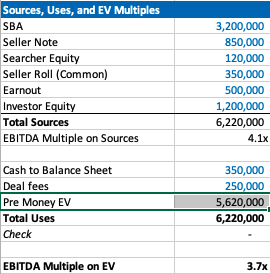
Our example company has $1.5 mm of EBITDA, so the EBITDA multiple is 3.7x. This is a pretty attractive acquisition multiple for a business that meets traditional search criteria (recurring revenues, fragmented competition, high gross margins, low customer concentration, etc).
If you’re seeing a search fund deal for the first time, the headline of “we’re buying a decent company for 3.7x, and replacing a tired owner with a hungry operator” is pretty exciting!
However, if you’re an investor, there is some nuance to this enterprise value number and the true EBITDA multiple you are investing in.
The trick with self funded enterprise value
The security that most self funded search investors get in a deal is participating preferred stock with a paid in kind dividend. This means when there’s an exit, you get your money back before any other equity holder, then get a certain percent of the business, and whatever dividend you’ve been owed in the interim accrues to your principle.
It’s a really favorable security for the investor, and one that is basically impossible to get in VC where straight preferred stock is much more common (no pun intended).
The key terms are what percent of common equity does this security convert into after the originally principal is paid back, and what is the dividend.
The share of common equity the investor group will get typically ranges from 10-50% of the total common stock. The dividend rate is usually 3-15%. The average I’m seeing now is around 30% and 10% for common and dividends respectively.
The strange this about the enterprise value quoted to investors in a teaser/CIM is that it doesn’t change as the percent of common changes, even though this has large implications for how much the common equity is worth and the value investors receive.
For example, I may get a teaser where the sources of investment – cash to balance sheet – deal fees = $3.7 mm for a $1 mm EBITDA company, which would imply a 3.7X EBITDA multiple. Let’s say the searcher is offering investors 30% of the common and a 10% dividend.
Let’s now say that the searcher is having a tough time raising capital and changes their terms to 35% of common and a 12% dividend. Does the effective enterprise value change for investors? I would argue yes, but I would be surprised to see it changed in the CIM/teaser.
This isn’t a knock on searchers or the search fund community. It’s just kind of how things are done, and I think this is mostly because it’s really hard to think about how the enterprise value has changed in this scenario.
However, the natural way of using EBITDA multiples to think about value for a business that is so common in PE/SMB can be extremely misleading for investors here. You may be thinking 3.7X for this type of business is a great deal! But, what if the security you’re buying gets 5% of the common?
If you’re in our world, you may counter this point by saying most searchers will also supply a projected IRR for investors in their CIM. However, IRR is extremely sensitive to growth rate, margin expansion, and terminal value. While the attractiveness of the security will be reflected, it can be greatly overshadowed by lofty expectations.
To get more clarity and have a slightly different mental model on the effective price investors are paying for this business, let’s go back to basics. Enterprise value should be debt + preferred stock + common stock – cash.
We know the values of each of these numbers, except the common. So, the main question here becomes: how much is the common equity worth?
Calculating value of common equity for self funded search funds
Equity value for most search fund deals = preferred equity from investors + the common equity set aside for the searcher and sometimes also advisors, board, seller.
We know that the preferred equity is investing a certain amount for a certain amount of common equity. The rub is that they are also getting a preference that they can take out before any common equity gets proceeds, and they are getting a dividend.
So, the exercise of valuing the common equity comes down to valuing the preference and dividend.
In my mind, there are three approaches:
- The discount rate method where you take the cash flows you’ll get in the future from the pref/dividends and discount them back at the discount rate of your choice. I am using 30% in my model which I believe accurately compensates investors for the risks they are taking in a small, highly leveraged investment run by an unproven operator. If you believe in efficient markets, this number also fits as it mirrors the historical equity returns as reported by the Stanford report, with a slight discount given this asset class has clearly generated excess returns relative to other assets on a risk adjusted basis, hence interest in these opportunities from an expanding universe of investors.
- The second method is to calculate how much money you’d get from your preference and dividends, taking into account that per the Stanford study around 75% of search funds will be able to pay these sums, and then discount these cash flows back at a rate more in line with public equities (7% in my model). This yields a much higher value to the preference/dividend combo, and therefore lowers the implied value of the common equity.
- The last method is to just say nope, there is no value to the preference and dividend. I need them and require them as an investor, but they are a deal breaker for me if they aren’t there, and therefore they don’t exist in my math. This of course makes no logical sense (you need them, but they also have no value?), but I’ve left it in as I think many investors probably actually think this way and it creates a nice upper bound on the enterprise value. Side note, as with obstinate sellers, jerk investors are usually best avoided.
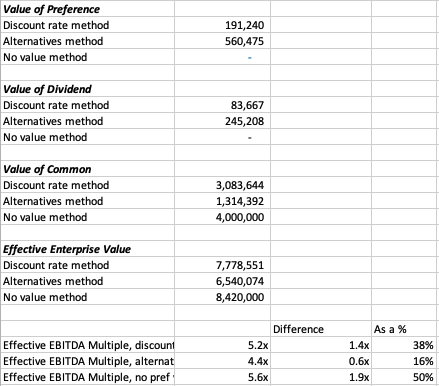
In our example, you can see a breakdown of the preference value, dividend value, and therefore common value and enterprise value for this deal.
In each case, the effective EBITDA multiple moves from 3.7x to something much higher (see the last 3 lines).
There are some simplifying assumptions in the model (no accruing dividend, all paid in last year), and some weird stuff that can happen (if you make the hold time long and the dividend greater than the 7% equity discount rate, the value of the dividend can get really big).
These flaws aside, I think this creates a nice framework to think through what the common is actually worth at close, and therefore what enterprise value investors will be paying in actuality.
It’s worth noting that the whole point of this is to benchmark the value you’re getting relative to market transactions in order to understand where you want to deploy your capital.
This creates a method to translate cash flow or EBITDA multiples of other opportunities on an apples to apples basis (if only there were a magical way to translate the risk associated with each as well!).
Another note, we could calculate the value of the common to be what this asset would trade at market today in a well run auction process minus any obligations (debt, preference, seller financing). However, I think that understates the option value inherent in this equity, a value that is only realized when a new manager takes over with more energy and know how.
There is a finance nerd rational for this. If you plot the value of equity in a leveraged company on a chart, it mirrors the payout of a call option. In both cases, the value of the security increases at a certain inflection point: when the value of equity rises above the strike price in an option, and when the enterprise value of a company rises above the debt level in a levered company.
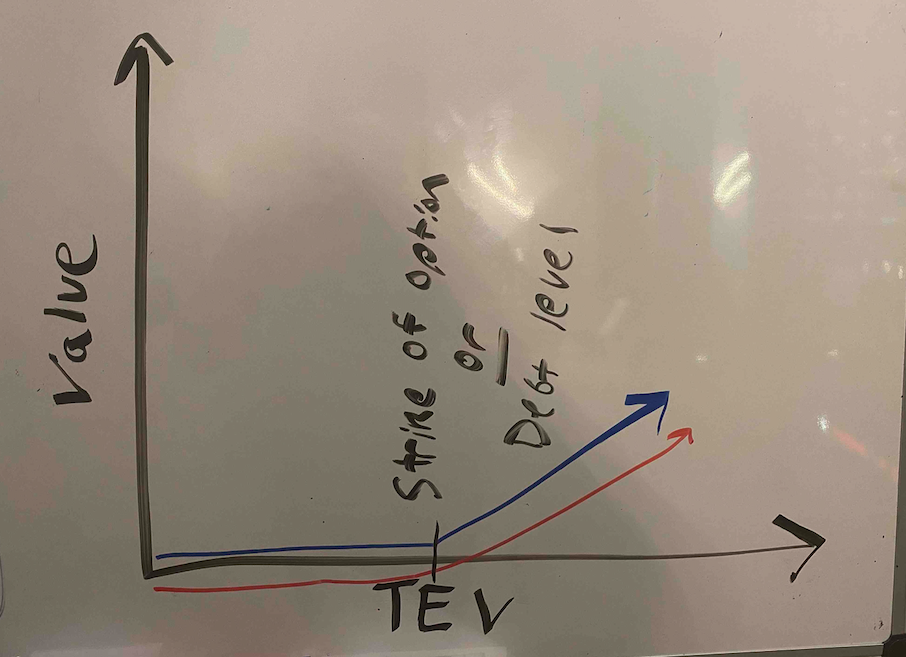
The common equity of a highly levered company can therefore be valued by a similar methodology as the call option: Black Scholes. If you remember back to finance class, increasing volatility will increase the value of an option.
In the search fund case, we’ve (hopefully) increased the (upside) volatility and therefore create more value than simply selling the company today.
A few more thoughts on investor economics
There are a few other ways to think about the economics you get as an investor to best understand if this is the deal for you.
First, you may want to think about how much your investment will be worth day 1. The key lever in this model is what discount this company is being bought for relative to fair market value. For example, the searcher may have proprietary sourced a great company and is buying it for 25% below what it would trade at in a brokered auction.
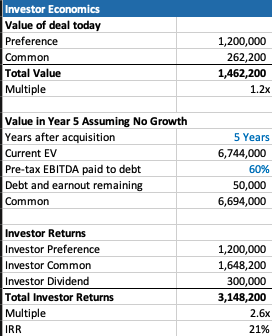
This is very much a “margin of safety” philosophy on things. Same with the calculation on how much you’ll receive in year 5 (after QSBS hits) assuming no growth in the business.
The only problem with each of these calculations is that they never play out in practice. Most companies don’t just stay the same, you’re either in a rising tide or you’re in trouble. And, you’re almost never going to sell in year 1, and definitely not for a slight premium to what it was bought for.
However, if your investment is worth 30% higher day one, and you can make a 20% IRR assuming nothing too crazy happens either way in the business, that’s not a bad place to start. Add in a strong searcher, decent market, some luck, and you’re off to the races.
Thoughts on searcher economics
A lot of this post has considered things from the investor perspective as my main quandary was related to how to create an EBITDA multiple that made sense for investors.
However, the point of this post is not to say searchers are misrepresenting or being unrealistic with their terms. In fact, I think it’s quite logical that self funded searchers capture the massive economic value that they do.
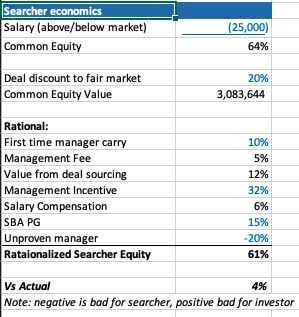
There are many reasons why self funded searchers deserve the lion share of the common equity.
First, they are providing a nice service of giving investors a positive expected value home to park their money with much lower correlation to the market than other asset classes ($1 mm EBITDA companies don’t see lots of multiple contraction/expansion throughout cycles).
Most money managers that fit that criteria are taking a 2/20, of course they also usually have a track record. So, I’ve used a 10% carry in my model, but stuck to 2% annual management fee.
The searcher spent a lot of time, and probably money, finding this company. That’s a lot of value, especially if it’s a below market price. They should be able to capture a lot of the value in finding a below market deal.
The searcher may be taking a below market salary, and needs to get comped like any CEO, with stock options. In my example model I have $1 mm of stock vesting over the hold period, as well as extra comp for taking a below market salary.
Searchers are also usually putting their financial standing at risk by taking a personal guarantee on the bank/SBA loan. This is really tough to put a number on, as is the last line in my framework where searchers are dinged for lack of experience. Like any good model, you need a few lines that you can fudge to make the math work 🙂
What you do think?
I’m shocked that I wrote all this. I was going to type a few paragraphs and a quick excel. However, putting this to paper has been a great exercise for me to sharpen my thinking.
Now I’d like you to help me further. Where do you think this should be changed in this framework? How do you think about things from the investor and/or searcher side?
Feel free to shoot me a note if you have thoughts (even just to tell me I’m being way too academic with this, which I actually agree with).
Lastly, a post like this is really a trap I’m putting on the internet to catch any like minded people in so that we can figure out ways to collaborate now or in the future. So, at the very least, connect with me on LinkedIn 🙂
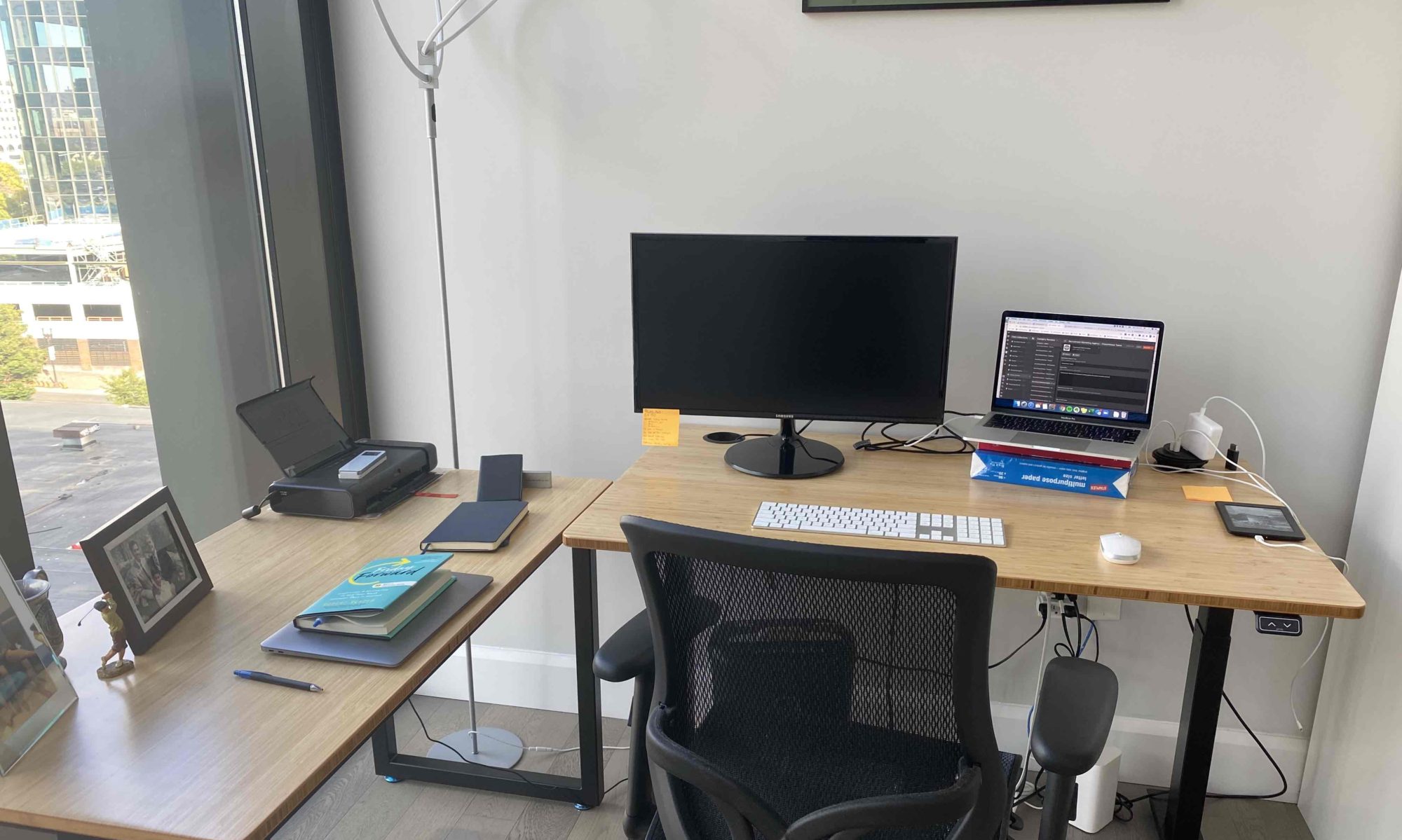
Heya are using WordPress for your blog platform? I’m new to the blog world but
I’m trying to get started and create my own. Do you need any html coding knowledge to make your own blog?
Any help would be greatly appreciated!
Pretty nice post. I just stumbled upon your weblog and wished to say that I
have truly enjoyed browsing your blog posts.
In any case I’ll be subscribing to your rss feed and I hope you write again soon!
This design is spectacular! You certainly know how to keep a reader amused.
Between your wit and your videos, I was almost moved
to start my own blog (well, almost…HaHa!) Fantastic job.
I really loved what you had to say, and more than that, how you presented
it. Too cool!
Hello there, I do think your web site might be having browser compatibility
issues. Whenever I take a look at your website in Safari,
it looks fine but when opening in Internet Explorer,
it’s got some overlapping issues. I just wanted to give you a
quick heads up! Aside from that, wonderful website!
If some one wishes to be updated with newest technologies after that he
must be visit this web page and be up to date all the time.
This design is wicked! You obviously know how to
keep a reader entertained. Between your wit and your videos, I was almost moved to start my own blog (well, almost…HaHa!) Excellent job.
I really loved what you had to say, and more than that,
how you presented it. Too cool!
Great goods from you, man. I have understand your stuff previous to and
you’re just too fantastic. I actually like what you have
acquired here, really like what you’re saying and the way in which you say it.
You make it enjoyable and you still take care of to
keep it sensible. I can’t wait to read much more from you.
This is really a great website.
For most up-to-date information you have to pay a visit world-wide-web and on web I found this site as a best site
for most recent updates.
I am actually pleased to glance at this web site posts which consists of plenty of helpful data,
thanks for providing such data.
I loved as much as you’ll receive carried out right here.
The sketch is tasteful, your authored material stylish.
nonetheless, you command get bought an impatience over that you wish be delivering the following.
unwell unquestionably come more formerly again as exactly the
same nearly very often inside case you shield this increase.
Hey there! I know this is kind of off topic but I was wondering which
blog platform are you using for this website? I’m getting sick and tired of WordPress because I’ve had problems with hackers and I’m looking at alternatives for another
platform. I would be awesome if you could point me in the direction of
a good platform.
Hi there, I discovered your site by means of Google whilst searching for a
comparable subject, your site came up, it looks good. I have
bookmarked it in my google bookmarks.
Hi there, just was alert to your weblog thru Google, and located that it is
truly informative. I’m going to watch out for brussels.
I’ll appreciate in the event you proceed this in future.
Lots of folks shall be benefited from your writing.
Cheers!
I’m not sure exactly why but this web site is loading
incredibly slow for me. Is anyone else having this issue or is it a
problem on my end? I’ll check back later on and see if the problem still exists.
Hi, I do believe this is a great site. I stumbledupon it ;
) I’m going to revisit once again since i have book marked it.
Money and freedom is the greatest way to change, may you be rich
and continue to guide others.
I am regular visitor, how are you everybody? This piece of writing posted at this site is truly fastidious.
It’s really a nice and useful piece of info. I am satisfied that you simply
shared this useful info with us. Please keep us up to date like this.
Thanks for sharing.
Hi to every one, because I am actually keen of reading this web
site’s post to be updated regularly. It contains nice stuff.
Yes! Finally someone writes about situs judi slot online.
Pretty nice post. I just stumbled upon your weblog and wished
to say that I’ve truly enjoyed surfing around your blog posts.
In any case I’ll be subscribing to your rss feed and I hope you write again soon!
This piece of writing is genuinely a nice one it assists new internet users,
who are wishing in favor of blogging.
Howdy! This post could not be written any better!
Reading this post reminds me of my previous room
mate! He always kept chatting about this. I will forward this article to him.
Fairly certain he will have a good read. Thank you for sharing!
Hi there colleagues, how is all, and what you want to say regarding
this paragraph, in my view its truly awesome for me.
Heya! I’m at work surfing around your blog from my new apple
iphone! Just wanted to say I love reading your blog and look forward to all your posts!
Keep up the great work!
I will immediately clutch your rss as I can not find your e-mail subscription link or e-newsletter
service. Do you have any? Kindly permit me know in order that I
could subscribe. Thanks.
Hi! This post couldn’t be written any better!
Reading through this post reminds me of my old room mate!
He always kept talking about this. I will forward this write-up to him.
Fairly certain he will have a good read. Many thanks for sharing!
Hello, this weekend is good for me, because this time i am
reading this great informative paragraph here at my
residence.
This is my first time go to see at here and i am genuinely pleassant to read everthing
at single place.
Hi there! I’m at work surfing around your blog from my new
iphone 4! Just wanted to say I love reading your blog and look forward to all your
posts! Keep up the outstanding work!
When someone writes an paragraph he/she retains the idea of a user in his/her mind that how
a user can be aware of it. Thus that’s why this post is outstdanding.
Thanks!
Good day! I know this is kind of off topic but I was wondering which blog platform are you using for this site?
I’m getting tired of WordPress because I’ve had problems
with hackers and I’m looking at options for another platform.
I would be awesome if you could point me in the direction of a good platform.
Hello, i think that i saw you visited my weblog so i came to
“return the favorâ€.I am trying to find things to
improve my web site!I suppose its ok to use some of your ideas!!
Very good write-up. I definitely love this website. Keep writing!
You are so cool! I don’t believe I’ve truly read a single thing
like that before. So nice to discover someone with genuine thoughts on this issue.
Seriously.. thanks for starting this up. This site is
something that is needed on the web, someone with a little originality!
I was wondering if you ever thought of changing the page layout of your site?
Its very well written; I love what youve got to say. But maybe you could a little more in the way
of content so people could connect with it better. Youve got an awful lot of text for only having 1 or
two images. Maybe you could space it out better?
Hello there I am so happy I found your site, I really found
you by accident, while I was browsing on Aol for something
else, Anyways I am here now and would just like to say kudos for a incredible post and a all round interesting blog (I also
love the theme/design), I don’t have time to go through it all at the minute but I have book-marked it and also added in your RSS feeds, so when I have
time I will be back to read a lot more, Please do keep up
the awesome work.
I think this is one of the most significant info for me.
And i’m glad reading your article. But want to remark on few general things, The site style is great, the articles is really great :
D. Good job, cheers
What’s up, this weekend is nice for me, as this occasion i am reading this enormous informative piece of writing here at my home.
Hello, Neat post. There’s a problem together with your
site in web explorer, could check this? IE still is the marketplace chief and a large component to folks will leave out
your magnificent writing due to this problem.
Heya this is kinda of off topic but I was wondering if blogs use WYSIWYG editors
or if you have to manually code with HTML. I’m starting a blog soon but have no coding skills
so I wanted to get advice from someone with experience.
Any help would be enormously appreciated!
Hey very interesting blog!
What’s up, its fastidious paragraph on the topic of media print, we all be aware of media is a enormous source of data.
My brother suggested I might like this website. He was totally right.
This submit actually made my day. You can not consider simply how
much time I had spent for this information! Thank you!
If you would like to get a great deal from this paragraph then you have to apply
such strategies to your won web site.
As the admin of this web site is working, no doubt very quickly it
will be renowned, due to its feature contents.
I’m impressed, I must say. Rarely do I come across a blog that’s both educative and engaging, and without a
doubt, you’ve hit the nail on the head. The issue is something
that too few people are speaking intelligently about. I’m very happy that I came across this during my search for
something concerning this.
I’ll right away grasp your rss as I can’t to find your email
subscription hyperlink or newsletter service. Do you have any?
Kindly let me understand in order that I may subscribe.
Thanks.
I blog quite often and I genuinely thank you for your content.
The article has truly peaked my interest. I’m going to take a note of
your blog and keep checking for new details about once per week.
I subscribed to your RSS feed too.
Hi I am so excited I found your weblog, I really found you by error, while I was looking
on Digg for something else, Anyways I am here now and would just like
to say thanks a lot for a incredible post and a all round interesting blog (I also love the theme/design), I don’t have time to browse it all at the minute
but I have saved it and also added your RSS feeds,
so when I have time I will be back to read more, Please do keep
up the great jo.
Hi! Would you mind if I share your blog with my zynga group?
There’s a lot of folks that I think would really appreciate
your content. Please let me know. Cheers
Thanks for finally writing about > Thoughts on Search Fund Economics – Phil Strazzulla's
Blog < Liked it!